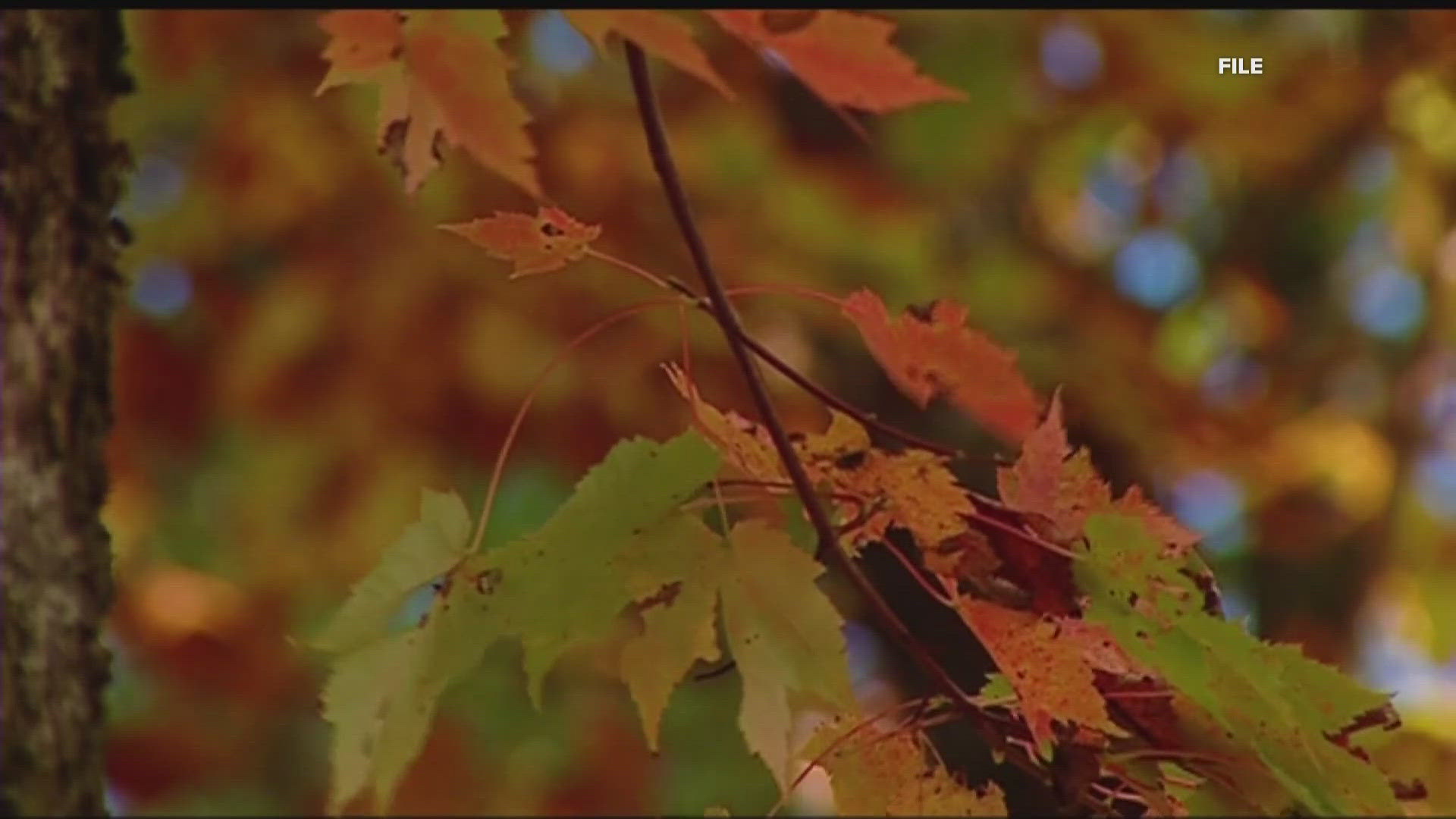ELLIJAY, Ga. — Autumn arrives Sunday, Sept. 22. Although fall decorations have been in big box stores for months now, we'll have to wait longer before we see significant fall color on the trees in north Georgia.
Our 11Alive Weather Impact Team set out to break down the 'science' behind why our leaves change colors and how the weather can impact them. We talked to experts who explained when this year's peak could happen and how our fall foliage seasons are evolving over time.
The Science of Fall Color
In the summer, leaves are green in color because of Chlorophyll. As we transition into fall, our days turn shorter and cooler. The trees begin their process of preparing for winter. This process is referred to as 'Senescence'. It includes color change and leaf drop.
With this, chlorophyll production slows down. The chlorophyll breaks down, and the green color disappears. This unmasks other brilliant colors in the leaves brought on by other pigments in the leaves.
Carotenoids produce hues of yellow and orange. These pigments are established in the leaves in the spring and act as antioxidants for the leaf.
Anthocyanin produces deeper red to purple hues. It is produced within the sugars in the leaf cells towards the end of the growing season.

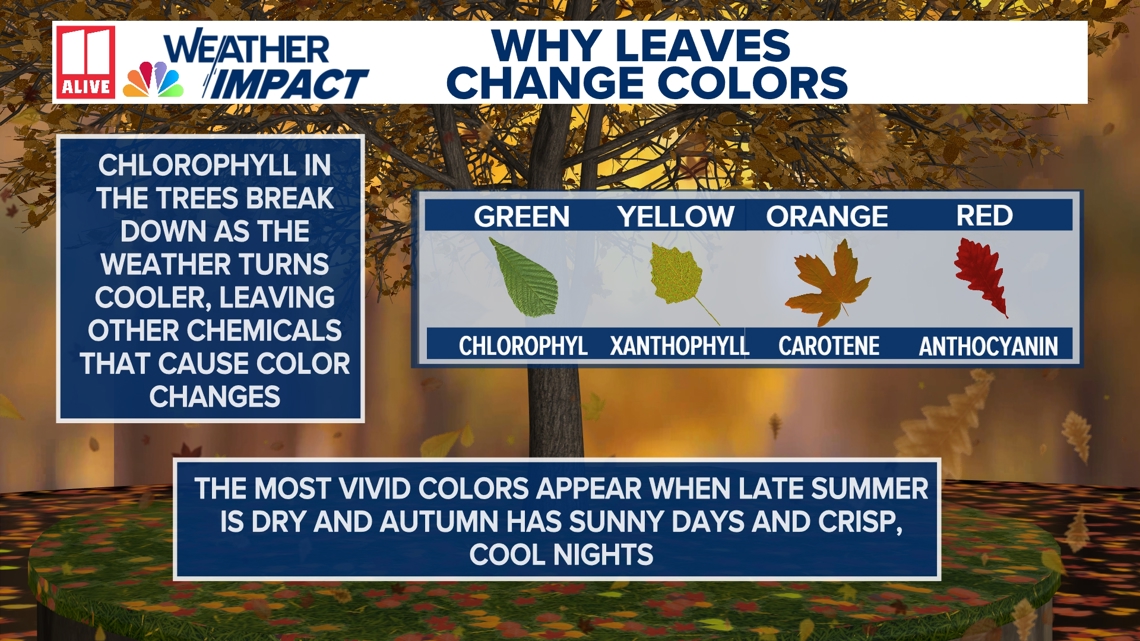
Each tree species changes colors at different times, and not all tree species produce the same hues of fall color. And the orchestral masterpiece of fall foliage transition each year has a pattern.
Former University of Georgia Professor of Tree Biology and Health, Dr. Kim Coder, developed a Tree Manual of Fall Color Development, which describes the biology and chemical processes happening as leaves prepare for winter. In his Coder Fall Color Propagation Model, he breaks down the color transitions as we move further into fall.
Yellow colors appear first, followed by orange hues, and finally deeper reds. Dr. Coder refers to the 'peak' time frame when orange colors are in their peaks, yellow is still somewhat vibrant, and red is on the upswing.

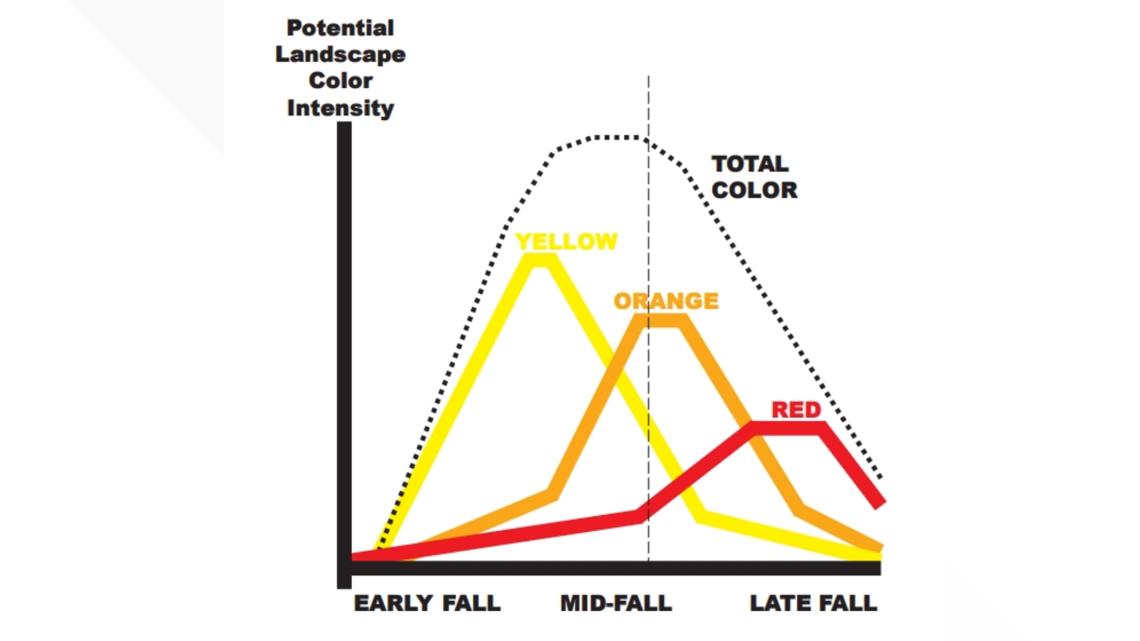
Weather Impacts on Fall Foliage
The weather impacts the speed of the color change -- and can impact how vibrant of a peak we end up seeing.
For the best peak, we want a wet summer but drier conditions in the fall. This includes crisp, cool overnights and a series of sunny, mild afternoons.
Benjamin Cobb is a Forester with the Georgia Forestry Commission and explains that a side-step from those ideal weather conditions can play a big role in how vibrant a fall's peak color can be.
"If we have a lot of warm, cloudy and rainy days from mid-September through mid-October, that's going to lead to a much more muted and cloudy display of the fall colors."
Cobb said the best time to view the fall colors in the north Georgia mountains will be just over a month from now.
"Some of the best colors can come from Sourwoods, Maples, your Scarlett Oaks, which has a crimson color, as the name implies. That normally shows best between the end of October and first of November," Cobb said.
When To Expect The Best Color
Although it's hard to predict an exact peak date or week until the color change begins, here's when the fall foliage peak typically happens in north Georgia, according to data from ExploreFall.com.
Streaks of bright sunny days and very crisp, cool nights (without a frost/freeze), can push the process along quicker. Meanwhile, warmer stretches can delay the process. Remember, this fall color process is gradual, and different trees will peak at different times!
Once we start seeing color change in the mountains, the Georgia Forestry Commission usually issues weekly updates of conditions so you can know what areas are best to see!
The peak of fall foliage across the area will happen first across the north Georgia mountains. There, the color change should happen in the back half of October, peaking around the end of the month. Some spectacular color can last into the first of November in northeast Georgia as well.

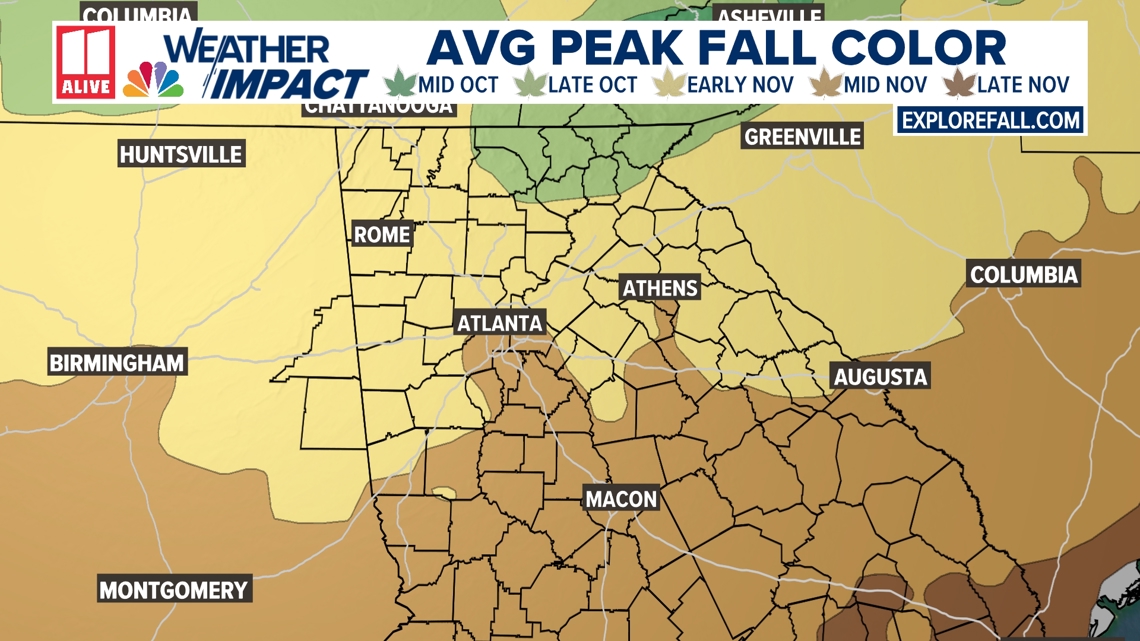
For the north side of the metro, we typically see more yellow colors around Halloween, with a peak in early November. This includes portions of Cobb, northern Fulton, and Gwinnett counties.
Further south, that peak date takes another week or two. Across the southern half of the metro, the typical peak of fall color happens closer to mid-November. This includes the southern half of the metro area, in places like Clayton, Henry, and parts of Fayette counties.

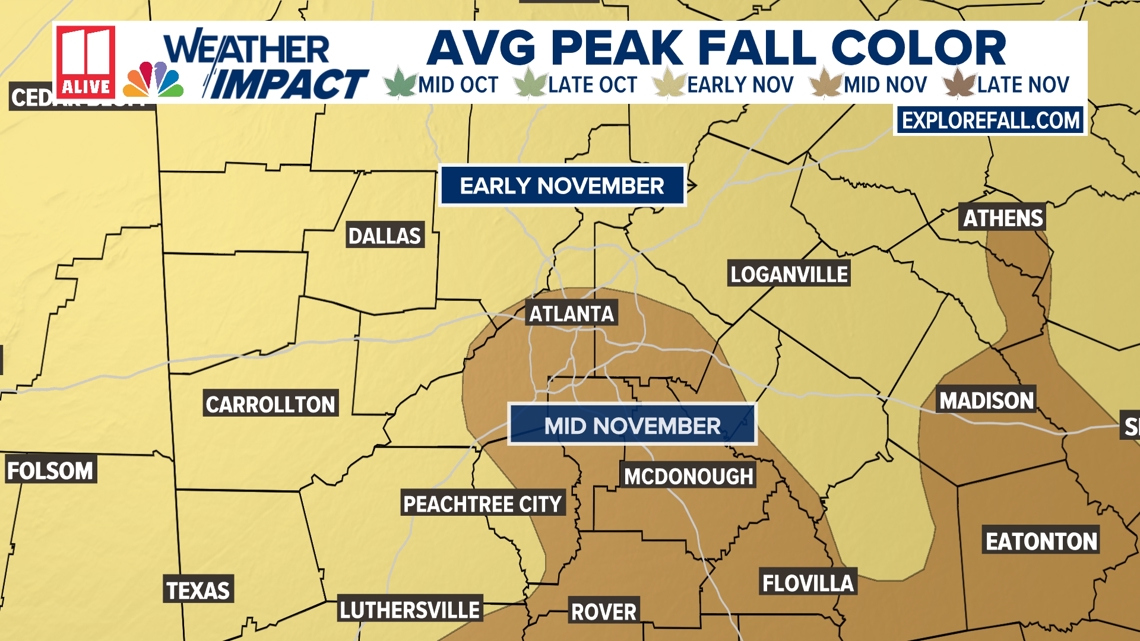
Fall Colors of the Future
"Your Children are not going to see the same widespread, intense color that you got to see when growing up"
Former University of Georgia Professor of Tree Biology and Health, Dr. Kim Coder, has been tracking fall foliage in north Georgia since his arrival at UGA in the mid-1980s.
Within his first few years as a Bulldog, he developed a predictive model that could identify a range of dates 30, 60, and 90 days out of when we'd see the peak of fall foliage.
"In the mid-1980s, I think our peak was like the 16th of October or something," Coder said.
His model worked fairly well for the first decade or so. But he started knowing that the trees became a lot less predictable by the turn of the century.
"By the mid-2000s, on average, every year, we were moving back the peak about a day and a half to two days. So now, we are at least 20 days later than we've ever been before," Coder said.
That delay in the trees changing colors is because our growing season is growing. Our first frost date is getting later, as well as our first freeze date. This graph below from Climate Central shows how Atlanta's growing season has expanded in the last 5 decades. Since 1970, our growing season (last spring freeze to first fall freeze) has been about 34 days longer, on average.
“We're seeing the trees stay green for a lot longer into the fall." Coder added.

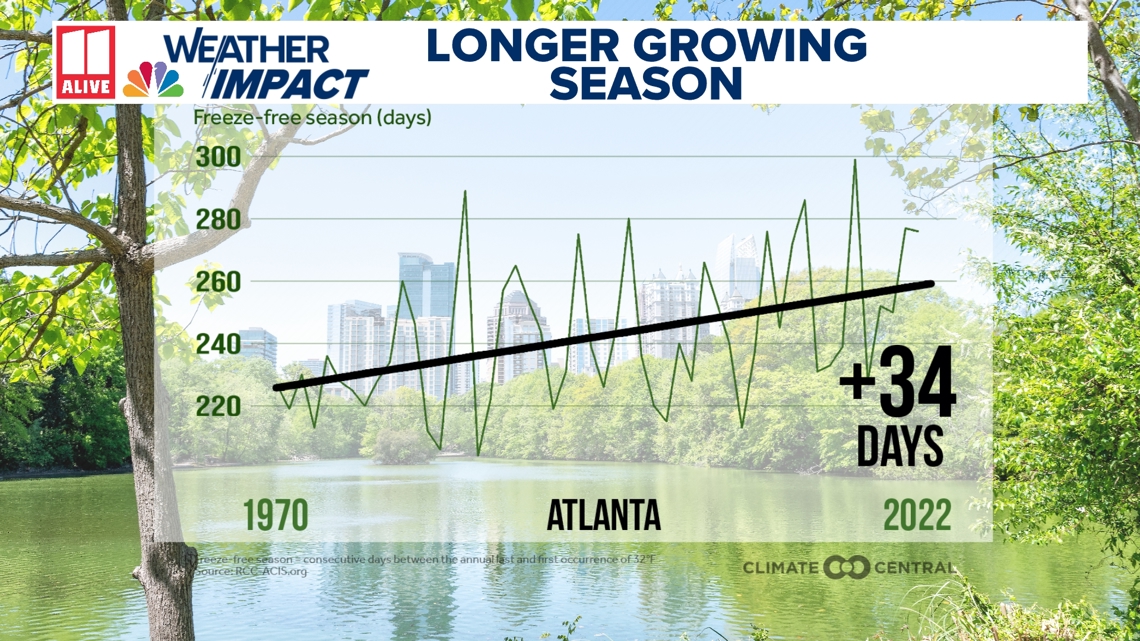
With the later fall color peak also comes some changes to how much fall color we see.
"Your Children are not going to see the same widespread, intense color that you got to see when growing up," described Dr. Coder, referring to the vibrancy of fall colors in the mountains. "You'll notice pockets. And these pockets will still exist, but it won't be landscape-wide like we've seen in the past."
Our state's trees and nature are still an absolute treat to enjoy, Coder stressed. "Things are just going to be different. They're not going to be bad, or better, or worse. Just different."
The nearly 40-year resident of the state and tree expert recommends taking a day-trip to the mountains to see the sights, "drive up north, see some colors, then stop at a winery, apple orchard or take a hike. Then drive a little and find another patch of fall color to enjoy."
Where To See Fall Colors
Whether you like to view fall colors at Piedmont Park in Atlanta or take a drive in the car up to your favorite scenic pass in northeast or northwest Georgia, the colors of fall make our state shine!
Here are some recommended locations to check out vibrant colors this fall:
Scenic route in northwest Georgia:
- Take I-75 to HWY 136, left on HWY 157 on top of Lookout Mountain
- Take a left on Daughtery Gap Rd. to the front of Mountain Cove Farms
- Turn right on Hog Jowl Rd., another right on HWY 193, follow it back to Lafayette and take a right on South Main St.
- Left on HWY 27 Bypass to the next intersection, which takes you back on HWY 136
Scenic route in northeast Georgia in the lower elevation:
- HWY 356 East from Unicoi State Park to HWY 197 and turn north
- Take HWY 197 up to Lake Burton or turn right onto Seed Lake Road
Scenic views in higher elevation:
- Richard Russell Scenic Highway
- Georgia HWY 180 from Vogel State Park to Lake Winfield Scott and Suches
We'd love to see your pictures of the leaves changing colors! This will help us track how quickly the changeover is happening this fall.
You can share them with us by joining our 11 Alive Weather Impact community on Facebook. Just search '11Alive Weather Impact.'

